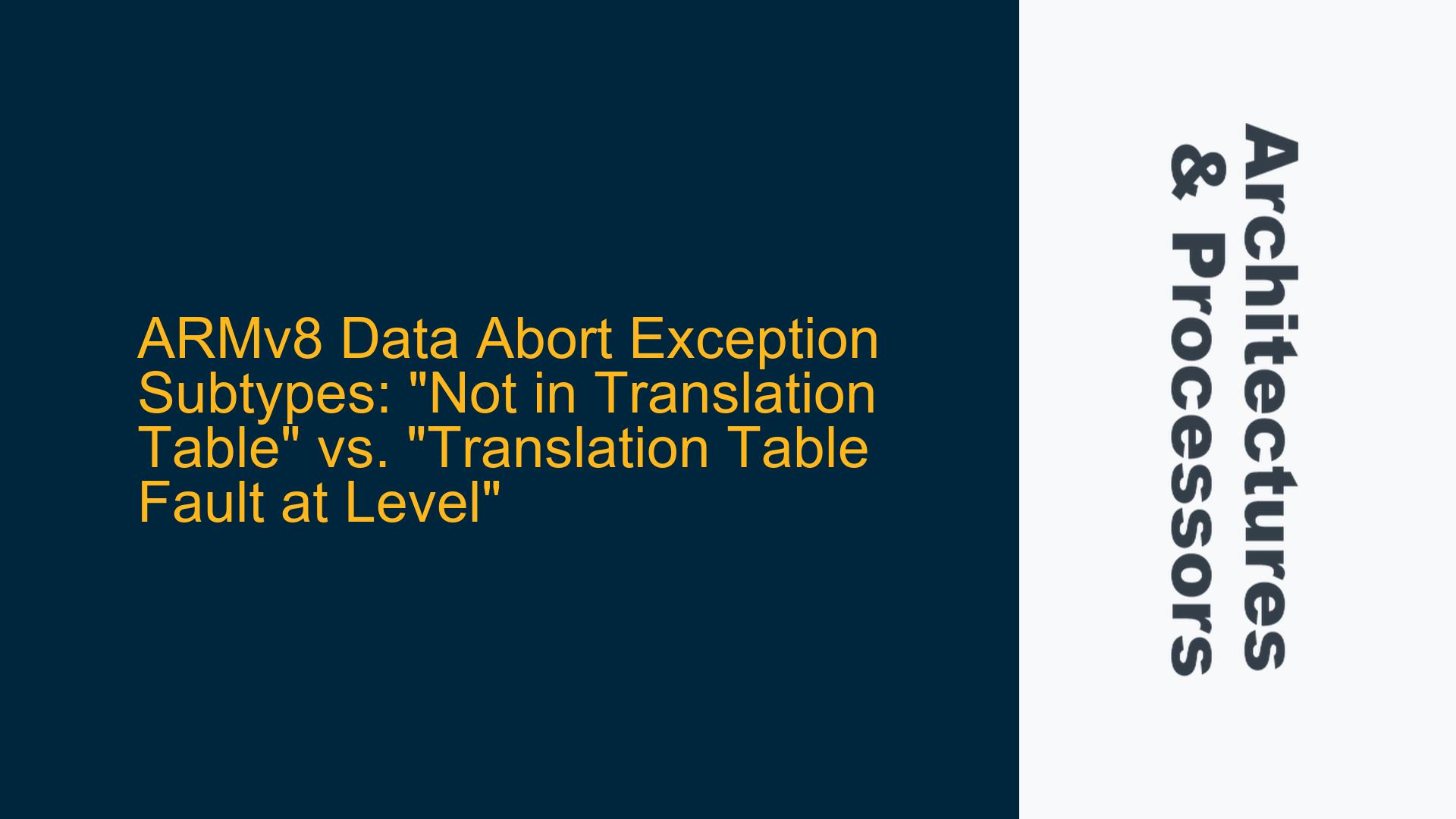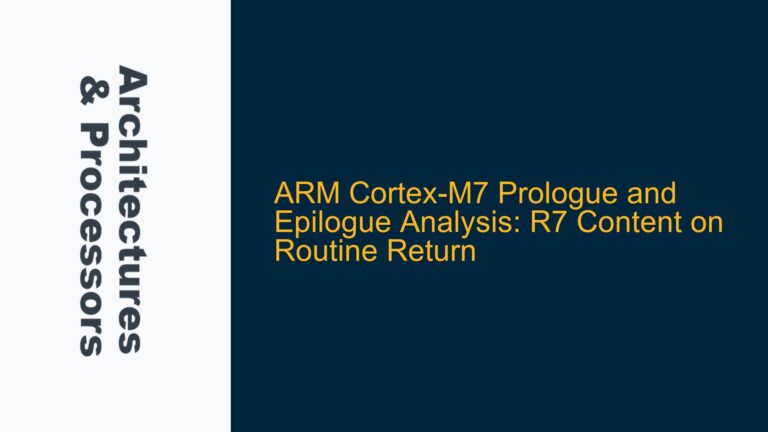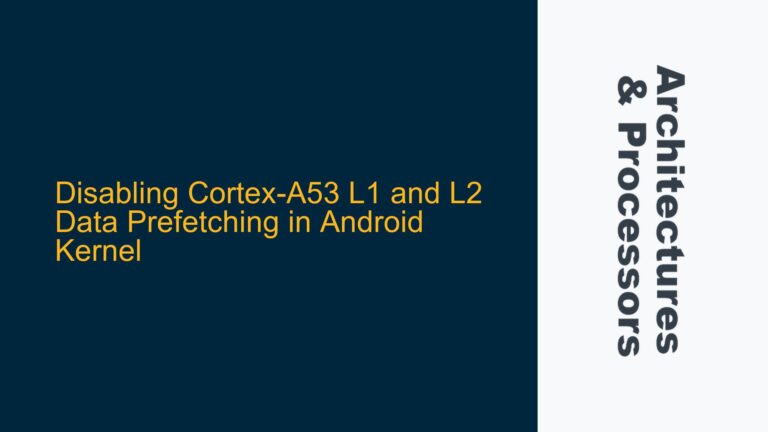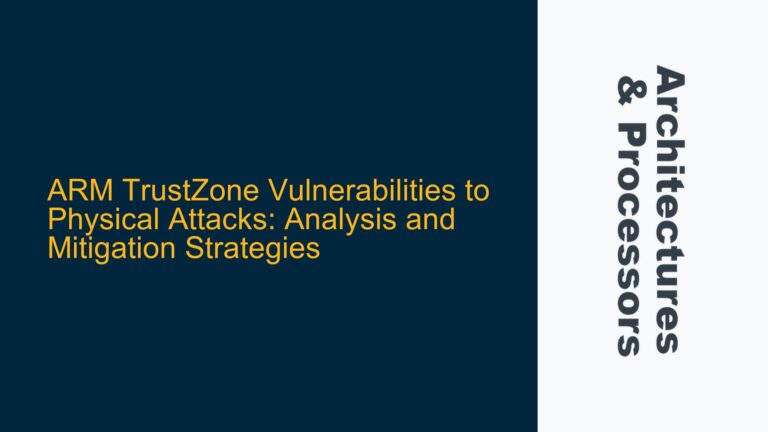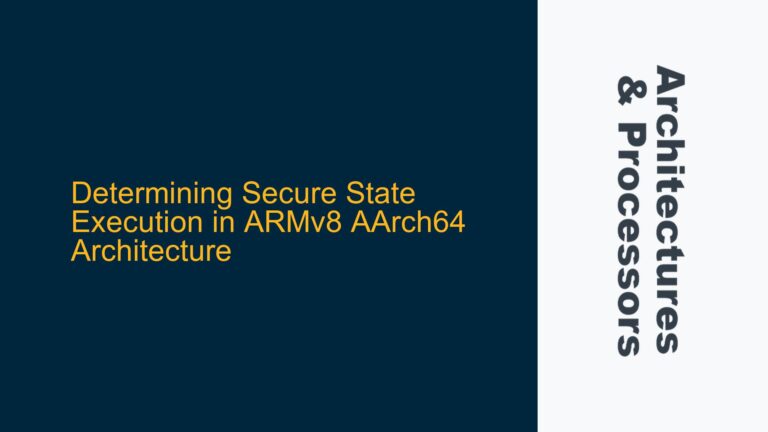Flash Memory Access Failures and Data Abort Exception Subtypes in ARMv8
The ARMv8 architecture introduces a sophisticated memory management system that relies on translation tables to map virtual addresses to physical addresses. When a memory access fails, the processor raises a Data Abort exception, which can be further categorized into subtypes based on the cause of the failure. Two such subtypes are "Not in Translation Table" and "Translation Table Fault at Level." Understanding the distinction between these subtypes is critical for diagnosing memory access issues, particularly when dealing with peripherals like Flash memory that may have unique access requirements.
In the context of the issue described, the Flash memory at physical address zero fails to map correctly, while other memory regions (UART, RAM, and Secure RAM) function as expected. The Data Abort exceptions observed during Flash access provide valuable clues about the underlying problem. Specifically, the exception subtypes "Not in Translation Table" (ESR.ISS = 0x10) and "Translation Table Fault at Level" (ESR.ISS = 0x06) indicate different failure mechanisms in the memory translation process. These subtypes are not interchangeable and point to distinct issues in the page table configuration or memory access permissions.
The root cause of the Flash memory access failure lies in the incorrect configuration of the Non-Secure (NS) bit in the page table entries. Flash memory in this system is designated as Secure-only, meaning it cannot be accessed when marked as Non-Secure. This misconfiguration leads to a "Not in Translation Table" exception, as the memory management unit (MMU) cannot resolve the address translation due to the access permission violation. In contrast, the "Translation Table Fault at Level" exception occurs when the MMU encounters an invalid or missing entry at a specific level of the translation table hierarchy.
Misconfigured Page Table Entries and Secure Memory Access Violations
The primary cause of the Flash memory access failure is the incorrect setting of the Non-Secure (NS) bit in the page table entries. In ARMv8, memory regions can be designated as Secure or Non-Secure, and this designation is enforced by the MMU. When a memory region is marked as Secure-only, any attempt to access it from a Non-Secure state will result in a Data Abort exception. In this case, the Flash memory is configured as Secure-only, but the page table entries incorrectly mark it as Non-Secure. This mismatch triggers the "Not in Translation Table" exception, as the MMU cannot proceed with the address translation.
Another potential cause is the granularity of the memory mapping. The Flash memory region spans a large address range (0x00000000 to 0x08000000), and the page table configuration may not account for this size properly. If the translation table entries are not aligned with the memory region boundaries or if the page size is mismatched, the MMU may fail to resolve the address translation correctly. This could result in a "Translation Table Fault at Level" exception, particularly if the fault occurs at a specific level of the translation table hierarchy.
Additionally, the issue may be exacerbated by the use of identity mapping, where virtual addresses are identical to physical addresses. While identity mapping simplifies the translation process, it can obscure subtle configuration errors, such as incorrect access permissions or misaligned page table entries. In this case, the identity mapping for the Flash memory region masks the underlying issue until a Data Abort exception is triggered.
Diagnosing and Resolving Flash Memory Access Issues in ARMv8
To diagnose and resolve the Flash memory access issue, follow these steps:
-
Verify Page Table Configuration: Examine the page table entries for the Flash memory region to ensure they are correctly configured. Specifically, check the Non-Secure (NS) bit and ensure it matches the Secure-only designation of the Flash memory. Use a debugger or memory inspection tool to dump the page table entries and verify their contents.
-
Check Memory Region Boundaries: Ensure that the Flash memory region is properly aligned with the page table entries. Verify that the page size and translation table levels are appropriate for the memory region size. For example, if the Flash memory spans 128 MB, ensure that the translation table entries use a block or section mapping rather than a smaller page size.
-
Review Access Permissions: Confirm that the access permissions in the page table entries are consistent with the memory region’s requirements. For Secure-only memory, ensure that the NS bit is cleared and that the appropriate access permissions (e.g., read-only, read-write) are set.
-
Test with Non-Identity Mapping: Temporarily switch to a non-identity mapping for the Flash memory region to isolate the issue. This can help identify whether the problem is related to the identity mapping configuration or the page table entries themselves.
-
Implement Exception Handling: Enhance the Data Abort exception handler to log detailed information about the faulting address, exception subtype, and translation table level. This information can provide valuable insights into the root cause of the issue.
-
Consult Documentation: Review the system documentation to confirm the memory region designations and access requirements. Pay particular attention to any notes about Secure-only memory regions or special considerations for Flash memory.
-
Update Page Table Entries: Correct the page table entries for the Flash memory region based on the findings from the previous steps. Ensure that the NS bit is cleared and that the access permissions are set correctly.
-
Test and Validate: After updating the page table entries, test the Flash memory access to confirm that the issue is resolved. Use a combination of read and write operations to verify that the memory region is accessible and that no Data Abort exceptions are triggered.
By following these steps, you can systematically diagnose and resolve Flash memory access issues in ARMv8 systems. The key is to carefully analyze the page table configuration, access permissions, and exception handling to identify and address the root cause of the problem.
Detailed Explanation of Data Abort Exception Subtypes
To further clarify the distinction between the "Not in Translation Table" and "Translation Table Fault at Level" subtypes, let’s delve into the ARMv8 architecture’s memory translation process. The MMU uses a multi-level translation table hierarchy to map virtual addresses to physical addresses. Each level of the hierarchy corresponds to a specific granularity of memory mapping, ranging from large blocks to small pages.
"Not in Translation Table" (ESR.ISS = 0x10)
This exception subtype indicates that the MMU encountered an issue before or during the translation table walk. Specifically, it means that the translation table entry for the faulting address is either invalid or inaccessible. In the context of the Flash memory issue, this subtype is triggered because the MMU cannot resolve the address translation due to the incorrect NS bit setting. The Secure-only designation of the Flash memory prevents the MMU from accessing the translation table entry, resulting in a "Not in Translation Table" exception.
"Translation Table Fault at Level" (ESR.ISS = 0x06)
This exception subtype indicates that the MMU encountered an issue at a specific level of the translation table hierarchy. The faulting level is encoded in the exception syndrome register (ESR), allowing you to pinpoint the exact stage of the translation process where the failure occurred. In the context of the unmapped address issue, this subtype is triggered because the MMU encounters an invalid or missing entry at level 2 of the translation table hierarchy. This typically occurs when the page table entries are not properly configured for the faulting address range.
Comparison of Exception Subtypes
| Exception Subtype | ESR.ISS | Cause | Resolution |
|---|---|---|---|
| Not in Translation Table | 0x10 | Translation table entry is invalid or inaccessible | Verify NS bit and access permissions in page table entries |
| Translation Table Fault at Level | 0x06 | Invalid or missing entry at a specific level of the translation table | Check page table configuration and alignment for the faulting address range |
Understanding these exception subtypes is crucial for diagnosing memory access issues in ARMv8 systems. By analyzing the ESR and the faulting address, you can determine whether the issue lies in the page table configuration, access permissions, or translation table hierarchy.
Best Practices for ARMv8 Memory Management
To avoid similar issues in the future, follow these best practices for ARMv8 memory management:
-
Thoroughly Review Documentation: Carefully review the system documentation to understand the memory region designations, access requirements, and any special considerations for peripherals like Flash memory.
-
Use Consistent Page Table Configuration: Ensure that the page table entries are consistently configured across all memory regions. Pay particular attention to the NS bit, access permissions, and alignment with memory region boundaries.
-
Implement Robust Exception Handling: Develop a comprehensive Data Abort exception handler that logs detailed information about the faulting address, exception subtype, and translation table level. This information is invaluable for diagnosing memory access issues.
-
Test with Different Mapping Strategies: Experiment with both identity and non-identity mapping strategies to identify potential configuration errors. Non-identity mapping can help isolate issues related to address translation.
-
Leverage Debugging Tools: Use debugging tools to inspect the page table entries, monitor memory access patterns, and analyze exception behavior. These tools can provide real-time insights into the memory management process.
By adhering to these best practices, you can minimize the risk of memory access issues and ensure reliable operation of ARMv8-based systems.
